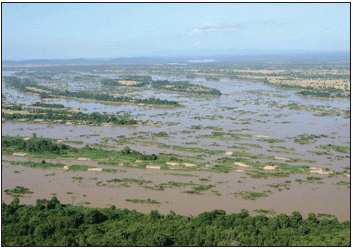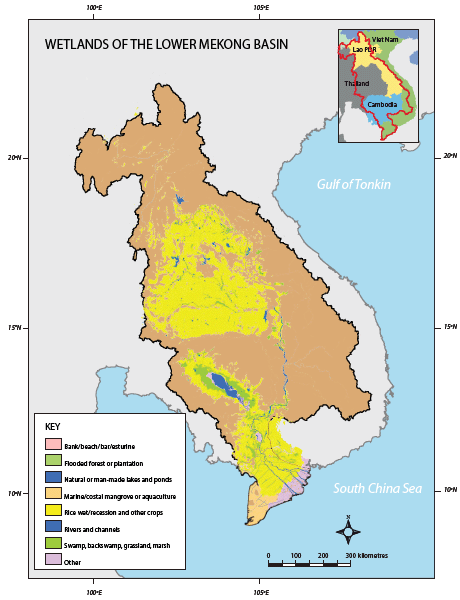2. Flood benefits
2.4 Flood benefits - the creation and maintenance of natural wetlands
Figure 2.8: Mekong wetlands at Sipandone,
Lao PDR.
Floodplain and wetland areas which are flooded part of the year or which expand greatly in area during the flood season can produce much far more aquatic resources than permanent water bodies of the same size, such as lakes and reservoirs (Figure 2.8). In fact, according to Ringler and Xai (2006) natural wetlands are amongst the most productive ecosystems in existence and the benefits from wetland products are often considerably higher per unit area than from other land uses. The benefits in terms of the regional fishery and other aquatic resources have already been considered and identified as huge, but wetlands also provide a wide range of additional ecological goods and natural services as specified in Table 2.5. These include physical benefits such as natural flood storage and flood attenuation, improved water quality through pollution control and waste dilution, habitat provision for resident and migratory species and the maintenance of important biochemical equilibria.
| Services | Comments and examples |
| Provisioning | |
| Food | Production of fish, wild game, fruits, grains. |
| Fresh water | Storage and retention of water, provision of water for irrigation and drinking. |
| Fibre and fuel | Production of timber, fuel wood, peat, fodder, aggregates. |
| Biochemical products | Extraction of materials from biota. |
| Genetic materials | Medicine, genes for resistance to plant pathogens, ornamental species etc. |
| Regulating | |
| Climate regulation | Regulation of greenhouse gases, temperature, precipitation and other climatic processes. |
| Hydrological regime | Groundwater recharge/discharge, water storage. |
| Pollution control | Retention, recovery and removal of excess nutrients/pollutants. Waste dilution. |
| Erosion protection | Retention of soils and prevention of channel erosion |
| Natural hazards | Flood storage, retention and attenuation |
| Cultural | |
| Recreational | Opportunities for recreational activities. |
| Aesthetic | Appreciation of the natural environment. |
| Educational | Opportunities for formal and informal education and training |
| Supporting | |
| Biodiversity | Habitats for resident and migratory species. |
| Soil formation | Sediment retention and accumulation of organic matter. |
| Nutrient cycling | Storage, recycling, processing and acquisition of nutrients. |
| Pollination | Support for pollinators. |
Wetland goods and services are particularly difficult to value, because:
- Many goods are not marketed but traded or consumed directly;
- Wetland services, such as water quality or groundwater recharge often occur in areas away from the physical location of the wetland and may not be easily attributable to the wetland itself;
- Many wetlands are trans-boundary resources and data on the use and consumption of goods and services are difficult to obtain, and;
- Many wetlands are public property.
Figure 2.9: Distribution
of 'wetlands' in the Lower Mekong Basin – though here no distinction
is made between natural flood inundated wetlands and rain
fed rice paddy. The latter would account for most of the area
specified in the Mun – Chi Basin in Thailand.
For these and other related reasons, the economic benefits generated by wetlands and the economic costs associated their degradation or loss are usually unknown and omitted in project and policy analysis. As a result, the potential of wetlands to be used as contributors to economic growth, income generating activities and as sources of goods and services has been underestimated in many parts of the world resulting in the loss of valuable species, services, and livelihoods.
The only detailed economic assessment of the value of the goods and services provided by natural wetlands within the Mekong region is that undertaken of the That Luang marsh in Vientiane municipality, Lao PDR by Gerrard (2004). Although it collects urban storm water runoff and some wastewater from the city, has a major flood control role and is not directly connected to the Mekong in terms of seasonal flood inflow, the results for That Luang provide an important pointer towards the potential wider regional economic value of natural wetlands. The total value of the goods and services provided by the 2000 ha marsh on an annual basis is summarised in terms of direct and indirect use values in Table 2.6:
| That Luang Wetland Uses and Services | Annual value (US$) |
| Wetland Resources – Direct use | |
| Rice cultivation | 350,000 |
| Garden cultivation | 55,000 |
| Aquaculture production | 180,000 |
| Capture fisheries. | 1,100,000 |
| Other aquatic products |
354,000 |
| Sub total | 2,040,000 |
| Wetland services – Indirect use. | |
| Flood protection |
2,850,000 |
| Wastewater purification |
70,000 |
| Sub total | 2,920,000 |
| Total |
4,960,000 |
Gerrard based the monetary value of the flood protection service provided by the marsh on figures available from the JICA feasibility study on the improvement of the drainage systems in Vientiane which was undertaken in 1990. This involved the assessment of inundation damage that would occur as a result of a 10 year storm without an improved drainage system for the city using unit cost values of damage to property, services and inventory based on surveys and land use. JICA recommended the construction of urban drainage canals (now completed) into the marsh as part of the overall plan and calculated the benefit of doing so in terms of the damage avoided within those areas of the city that would be drained of storm water in this way. Gerrard updated the cost benefit figures on the basis of the growth in the Gross Regional Domestic Product of the city over the years since 1990 and obtained the estimate for the flood protection services provided by That Luang given in Table 2.6.
Since the value of direct wetland uses has already been included in the analysis of regional agriculture and fisheries the focus here lies with wetland services. For That Luang the annual monetary benefit of flood protection and wastewater purification is estimated to be US$2,920,000, giving an annual unit area benefit of US$1,460/ha over the 2,000 ha of the marshland. In a study of one hundred and ninety wetland valuation studies worldwide Brander et al. (2006) observed that socioeconomic variables such as income and population density are important factors in explaining wetland value. Since in effect That Luang is providing municipal services directly to a large population its service value is estimated in terms of replacement costs, for example the construction of sewage treatment facilities and alternative flood protection and drainage infrastructure. Consequently the service value figure of US$1,460/ha would be higher than the average for regional wetlands as a whole.
Even so the average value of wetland services at this regional scale is not likely to be insignificant particularly with regard to their role in mitigating floods. It may seem to be a circular argument that, since the mainstream and tributary wetlands are by and large a product of the annual Mekong flood pulse, that one of their key benefits lies with flood attenuation. This, however, could be seen as positive feedback and simply as one sub-component of the hydrological dynamics of the system.
Other than the problem of placing a meaningful financial benefit on the services provided by regional wetlands another complication arises since it is difficult to derive the total area in the Lower Mekong Basin classified as such. Estimates vary. MacAlister and Mahaxay (2008) report that 40 million ha are mapped but that the thematic accuracy is poor, which precipitated their much more detailed mapping though no final figures were quoted for the Basin as a whole. The figure of 40 million ha is quite clearly unrealistic since it represents more than 60% of the Lower Basin area. Keskinen et al. (2008) quote a figure of five million hectares for the basin between Kratie and the South China Sea, which is consistent with estimates available from the Asean Regional Centre for Biodiversity and those quoted in Do and Bennet (2008). Of this total area the Cambodian floodplain comprises almost three million hectares.
Determining figures for Lao PDR and Thailand is more problematical. As MacAlister and Mahaxay (2008) found the categorization of wetlands and floodplain is complex upstream of Cambodia. Taking a wider view of the available data for the two countries then, excluding ‘closed’ wetland systems that are not directly connected to the Mekong drainage system, a figure of 250,000 ha seems reasonable. On this basis the overall regional figures can be broken down as shown in Table 2.7.
As a working assumption, if a minimum unit area value of the services provided by this area of floodplain and wetland is set at US$100/ha and a maximum figure of US$500 selected then the total regional benefit that accrues each year is as reported in Table 2.8.
The natural regulation of floodwater and reduction in peak discharges and water levels is the major service benefit. Floodwater is in effect stored on the flood plain and in the wetlands and released once the peak flow has occurred with the effect that flood recession is slower and therefore longer. This is of advantage particularly in the delta since the period of the year during which tidal influences dominate the diurnal pattern of water levels and therefore the risk of extensive saline intrusion is significant becomes shorter.
(LMB) contiguous with the Mekong drainage system.
| Sub area of LMB | Key
wetlands |
Area (ha) |
| Lao PDR and Thailand | Nam Songkhram | 100,000 |
| Se Champone | 24,000 |
|
| Siphandone | 6,000 |
|
| Se Kong | 35,000 |
|
| Se Pian | 30,000 |
|
| Other | 55,000 |
|
| Cambodia and Viet Nam | Cambodian floodplain | 3,000,000 |
| Delta floodplain | 2,000,000 |
|
| Regional Total | 5,250,000 |
Wetlands Biodiversity and Sustainable Use Programme statistics.
| Flood plain/wetland
area (million ha) |
Annual
value of services (US$ million) |
|
Minimum
based on a unit area service value of US$100/ha |
Maximum
based on a unit area service value of US$500/ha |
|
| 5.25 | 525 |
2,625 |
Other service benefits include the retention of sediment and organic matter within the floodplain and wetlands to the obvious advantage of agriculture and the aquatic ecosystem, pollution control and groundwater recharge and storage.
Choose a newsletter:

